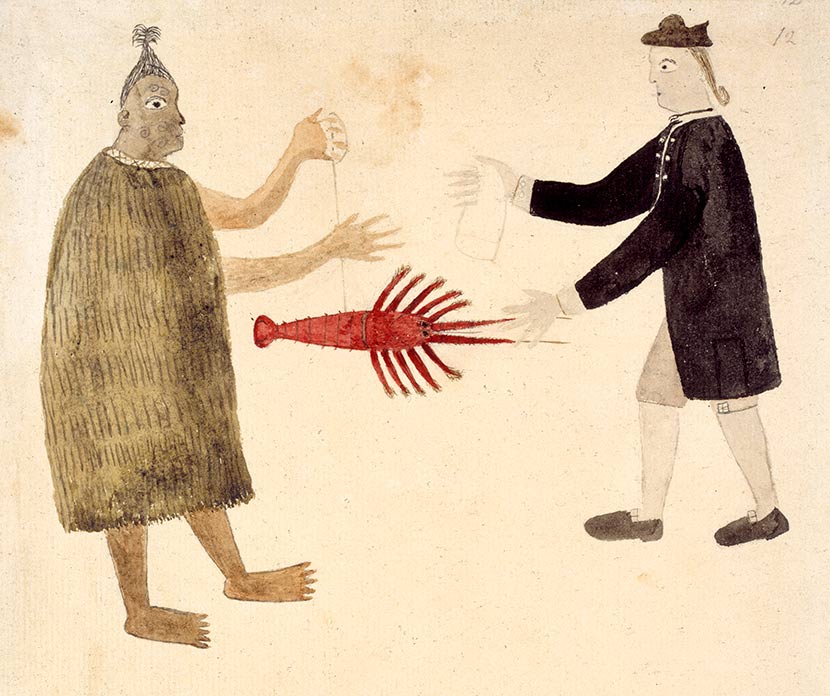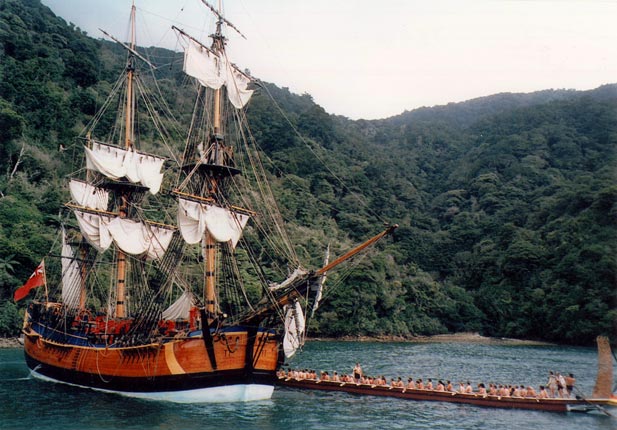On the evening of 18 December 1642, two waka of Ngāti Tūmatakōkiri people approached two strange ships, which had anchored near the north-western tip
of the South Island. These ships, the Heemskerck and the Zeehaen, were commanded by the Dutch explorer Abel Tasman. This was the first known occasion when Māori encountered Europeans.
The Māori group called out to the ships’ occupants and blew on a shell trumpet to challenge the intruders; the Dutch ship replied with their own trumpets. The next day, a waka approached with 13 Ngāti Tūmatakōkiri on board. They were shown gifts by Abel Tasman's men, but returned to shore. Seven more craft then came out to the ships. A small Dutch boat, which was passing a message between the two ships, was rammed by one of the waka and its occupants attacked; four of the Dutchmen died. As the ships weighed anchor and set sail, 11 canoes approached and were fired on, possibly causing injuries. As a result of the incident, Tasman never landed on New Zealand shores, and named the place Moordenaars Baij (Murderers Bay).
James Cook
For almost 130 years, Europeans and Māori had no further contact with each other. Then on 8 October 1769, James Cook and others landed on the east side of the Tūranganui River, near present-day Gisborne. It appears from later accounts that the local Māori at first took the ship to be a floating island or giant bird. The fertile land surrounding the wide bay Tūranganui-a-Kiwa was home to a large population of Māori at that time, divided into four main tribes.
Cook’s relationship with Māori got off to a disastrous start when a Ngāti Oneone leader, Te Maro, was shot and killed by one of Cook’s men. It seems likely that the local people were undertaking a ceremonial challenge, but the Europeans believed themselves to be under attack.
When Cook returned to shore the next day a large group of Māori gathered. This time Cook had brought with him the Tahitian tahua (priest) Tupaia, who was able to converse with the Māori. A local man greeted Cook with a hongi, possibly on Toka-a-Taiau, a sacred rock in the Tūranganui River. As historian Anne Salmond observed, this would have been a ‘portentious, powerful place for the first formal meeting between a Maori and European’.
However, another fracas occurred in which the Rongowhakaata chief Te Rakau was killed by the Endeavour’s company, and others wounded. This time it seems likely that Māori were attempting to exchange weapons, but this was misunderstood. Later that day Endeavour crewmen attempted to seize the occupants of fishing waka, with the intention of taking them on board and gaining their friendship. Further Māori deaths occurred during this incident and three youths were taken captive; they were later returned to shore.
Tupaia
During the first difficult days in Gisborne, another important moment of encounter took place, when the Tahitian tahua (priest) Tupaia came ashore from the Endeavour. Tupaia had been taken on board by Cook while in Tahiti and had proved himself a useful mediator between the Tahitians and the crew. Joseph Banks proposed that Tupaia and his servant Taiata come with them to England, and offered to pay for their passage.

After the Endeavour’s arrival in New Zealand the decision to take Tuipaia on board proved to have been an inspired one when it became clear that he could communicate with Māori. Because the Māori language belonged to the Polynesian sub-family of languages, Tupaia, who had learnt some English, was able to translate spoken exchanges between European and Māori. He also recognised Māori customs and could discuss complex subjects with local people.
The Endeavour would afterwards be remembered by Māori as ‘Tupaia’s ship’. The Tahitian priest was to have more influence on the local people – who regarded him as a tohunga from Hawaiki – than Cook or any other individual on board.
As his biographer says:
in recognition of his prestige as a Tahitian tahua, Tupaia was greeted as an honoured guest, enfolded in valuable cloaks and entrusted with ancient treasures. Disassociated from the homeland for perhaps 500 years, elders, priests, chiefs and their people welcomed this heaven-sent chance to reclaim their ancient past.
Hundreds gathered to hear Tupaia preach, while priests engaged him in religious discussions. As the ship sailed north to the Bay of Islands, Tupaia was welcomed and feted: he was a valued interpreter and mediator for the Māori people, as well as for the Europeans.
Cook relied on Tupaia’s diplomacy to smooth relations with Māori. At Uawa (Tolaga Bay) the Tahitian conversed at length with a local tohunga and also sketched and painted.
Inauspicious beginnings
Despite Tupaia’s mediation and translation skills, Māori understanding of Cook’s arrival and its significance was inevitably limited, although there was certainly some exchange of information between Māori and Cook’s men. If Europeans viewed Cook’s discoveries as momentous, for many Māori the visit must have seemed only a brief interlude in the normal course of life. Once their initial astonishment had passed, Māori dealt with the newcomers much as they dealt with Māori of other tribal groups.
Cook had been instructed to cultivate friendship and form alliances with the inhabitants of any new land he discovered. He is often credited with showing forbearance, restraint and understanding. Even so, his record is ambivalent: while he made every effort to avoid bloodshed, Māori were killed on both his first and second voyages to New Zealand. After the violence at Tūranganui-a-Kiwa, Cook sought to avoid conflict with local Māori as he travelled along the coast, and Tupaia played an increasingly important role as a cultural go-between. But misunderstandings over trade and protocol were common; two more Māori were killed in confrontations at Mercury Bay and the Cavalli Islands.
Cook’s discoveries helped forge New Zealand’s later links with Britain. In the late 18th and early 19th centuries a number of French explorers were active in the Pacific. Cook’s instructions from the British Admiralty authorised him to annex ‘convenient situations’ on any ‘great continent’ he might discover. At Mercury Bay on 15 November 1769, and at Queen Charlotte Sound on 30 January 1770, Cook made proclamations which helped ensure that Britain, and not another European power such as France, ultimately colonised New Zealand.
Encounters with other nations
At the same time as Cook was exploring New Zealand, and shortly after, other explorers were travelling around the coast of New Zealand and meeting with Māori. Many of these early encounters were disastrous – for example, the French captain Jean François Marie de Surville took savage reprisals on Māori who had found a small boat he had lost in storms at the end of 1769.
Soon after, in 1772, Marc Joseph Marion du Fresne spent five weeks in the Bay of Islands while undertaking extensive repairs. His initial encounters with Māori were friendly, and the expedition left an extensive record of Māori life. But du Fresne and two dozen of his crew were killed in mid-June, possibly for violating tapu or because Māori feared the establishment of a permanent settlement. In reprisal the French killed up to 250 people.





.jpg)
.jpg)
